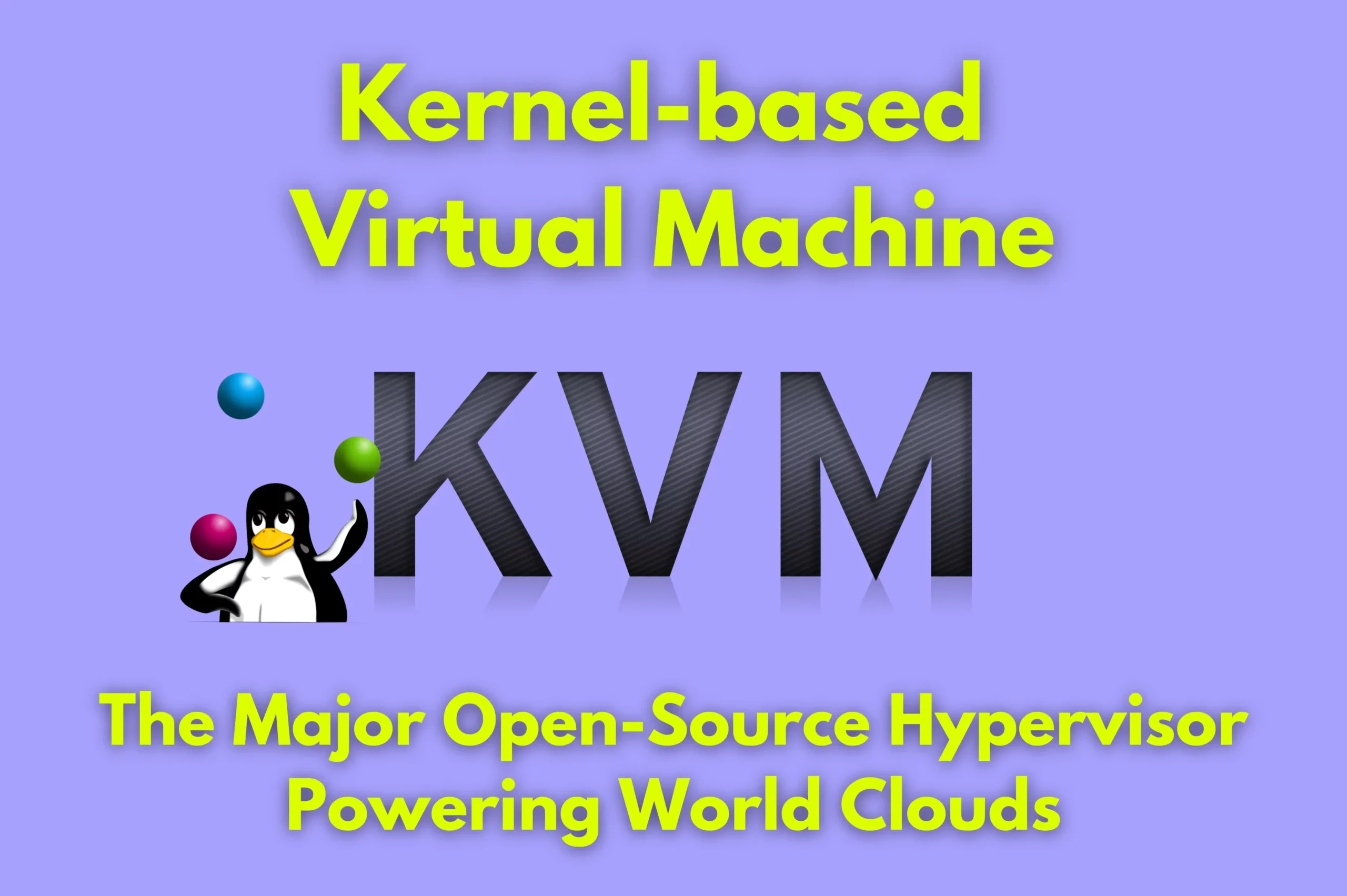Kernel-based Virtual Machine (KVM): The Major Open-Source Hypervisor Powering World Clouds
IT infrastructure wouldn’t be what it is today without virtualization. By optimizing resource utilization, ensuring workload isolation, and enabling cloud computing, virtualization has revolutionized modern IT infrastructures.
The concept of virtualization dates back to 1960 when the only way of running applications was bare metal and IBM introduced time-sharing systems to maximize the use of rare and expensive mainframe hardware. Over the decades virtualization shifted workloads from bare metal to Virtual Machines (VM’s) and more recently to Containers. It has evolved from hardware partitioning to hypervisor-based virtualization, which became mainstream in the early 2000s with the rise of x86-based virtualization and paved the way for Cloud computing as we know it today.
At the heart of virtualization is the hypervisor software and Kernel-based Virtual Machine (KVM) is among the most popular open-source hypervisors that is built-in directly into the Linux kernel.
KVM is widely adopted today in enterprise virtualization and all kind of cloud environments, making it the default hypervisor in OpenStack, including Cloudification’s c12n private cloud solution, and is used by major cloud providers such as Amazon Web Services (AWS), Google Cloud, Oracle Cloud, OVH, UpCloud and many others.
What is a Hypervisor?
Before diving into KVM in more detail, let’s take a look at hypervisors in general.
A hypervisor is software that enables virtualization by creating and managing virtual machines (VMs) on a physical host system. It allows multiple operating systems to run independently on the same hardware, maximizing resource efficiency and scalability.
Hypervisor Architecture
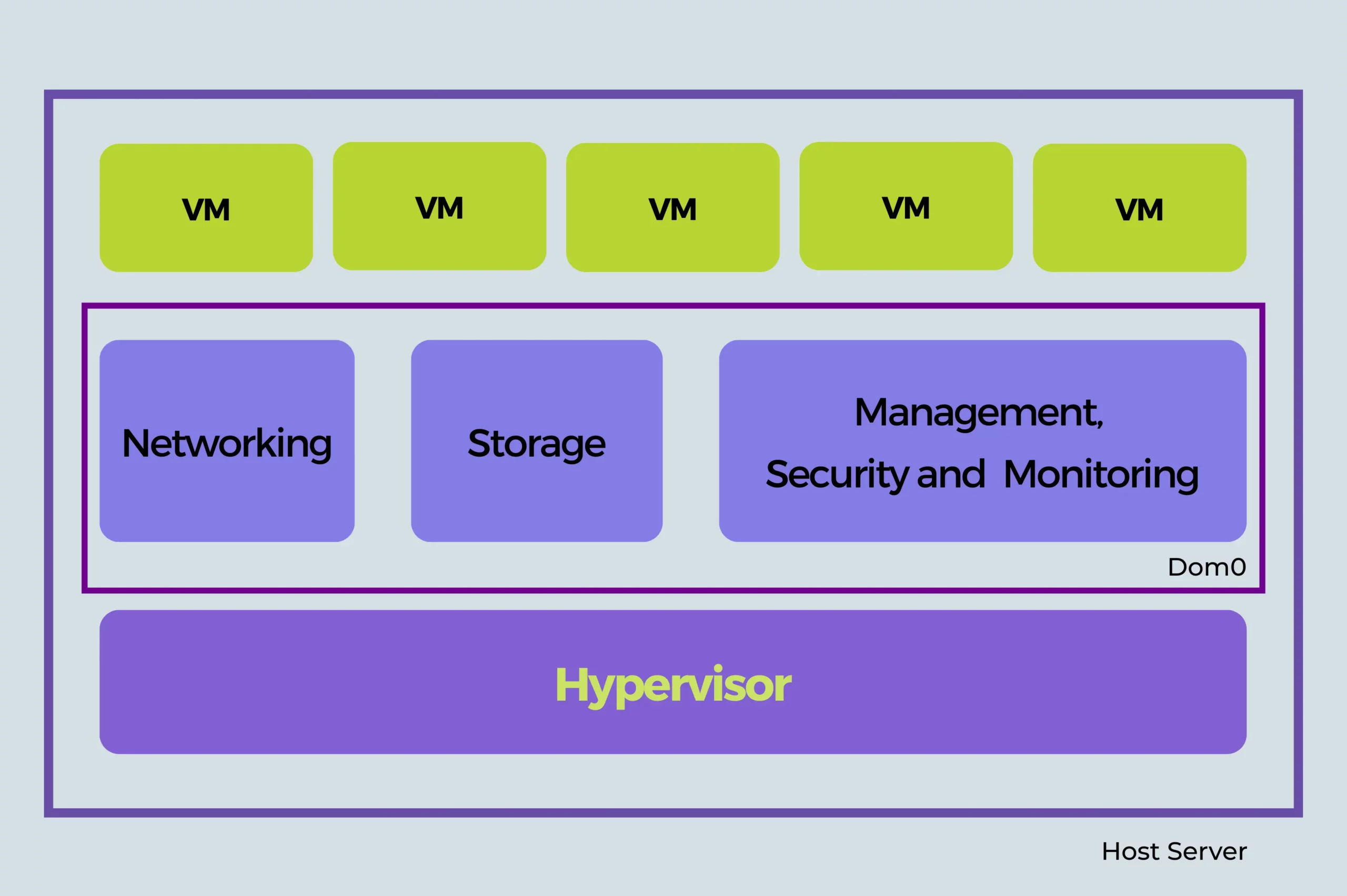
Hypervisors can be classified into two main types. While both hypervisor types serve the same purpose of running VMs, their concept is rather different.
Type 1 Hypervisors (Bare-metal)
Type 1 hypervisors directly access underlying hardware resources and do not require a host operating system (except for KVM which is part of Linux OS kernel). This architecture provides best performance, security, and resource efficiency. That’s why type 1 hypervisors are used in data centers, clouds and enterprises. The well-known examples of type 1 hypervisors are:
- KVM
- VMware ESXi
- Microsoft Hyper-V
- XEN
Type 2 Hypervisors (Hosted)
Type 2 hypervisors run as an application on top of a host operating system, making them easier to install and use, but generally less efficient than Type 1 hypervisors. They are often used for development, testing, and simple desktop virtualization. Examples include:
- VMware Workstation
- Oracle VirtualBox
- Parallels Desktop
Types of Hypervisors
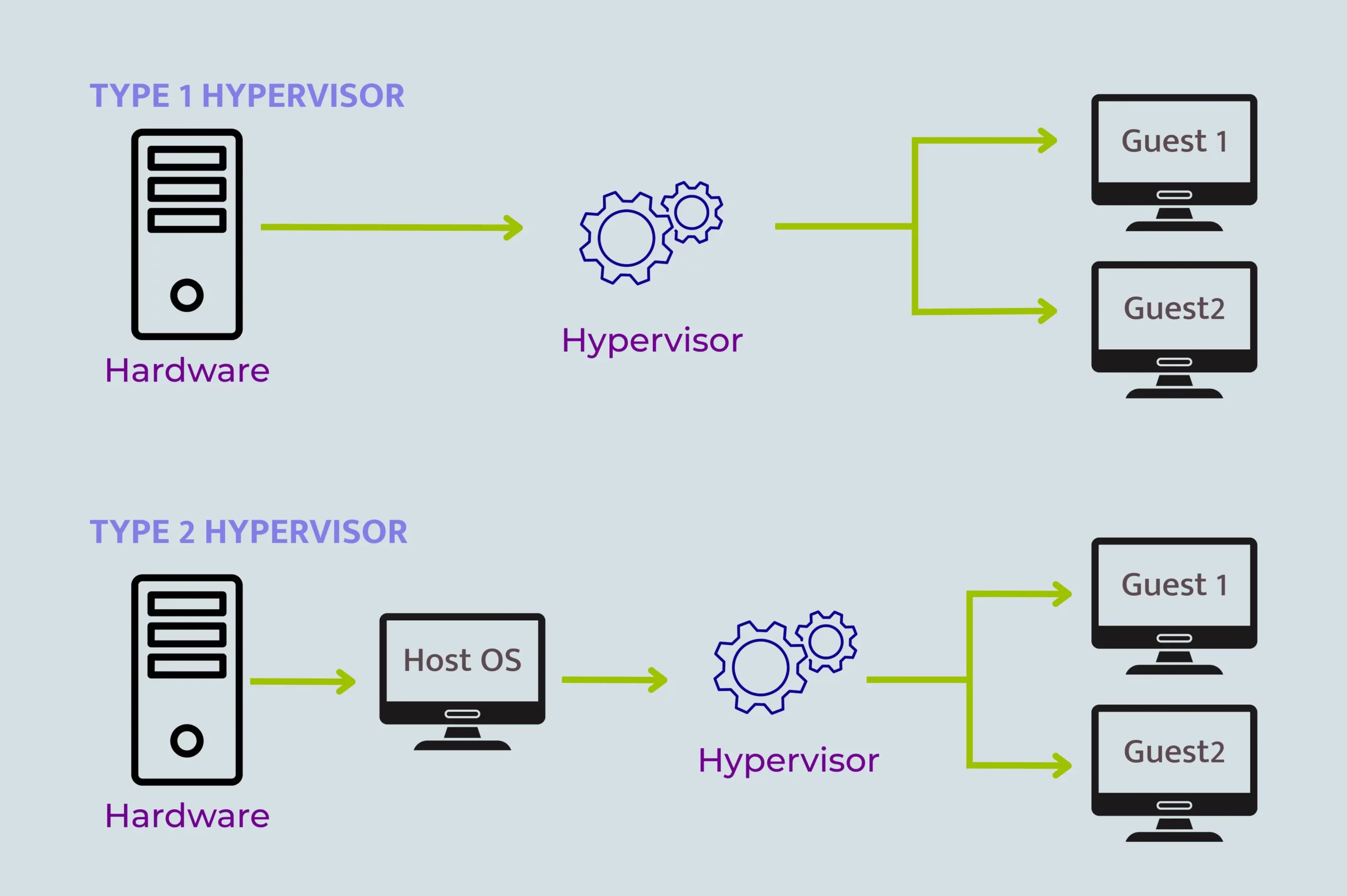
While KVM is classified as a Type 1 hypervisor, it operates within a Linux host, making it unique compared to traditional bare-metal hypervisors like ESXi or XEN. Because Linux itself runs on hardware, KVM inherits the performance advantages of a type 1 hypervisor at the same time benefiting from Linux’s vast ecosystem and security features.
What is KVM?
KVM is a part of the Linux kernel that allows to turn any modern Linux distribution into a fully functional hypervisor. KVM leverages the built-in capabilities of the Linux kernel, turning it into a robust virtualization platform that supports multiple guest operating systems, including Linux, Windows, BSD and even MacOS. The so-called guest operating systems are the OS which run on the VMs.
The core components of KVM include:
- A loadable kernel module (kvm.ko) that enables virtualization capabilities.
- CPU-specific modules (kvm-intel.ko and kvm-amd.ko) for hardware acceleration using Intel VT-x and AMD-V depending on the processor of the host.
- QEMU (Quick Emulator) integration, which provides device emulation and facilitates guest VM management. (We’ll talk about it in more detail below).
- Libvirt, a toolkit that provides an abstraction layer for managing virtualization platforms, including KVM, simplifying VM provisioning, automation, and orchestration.
Where does KVM fit into the stack?
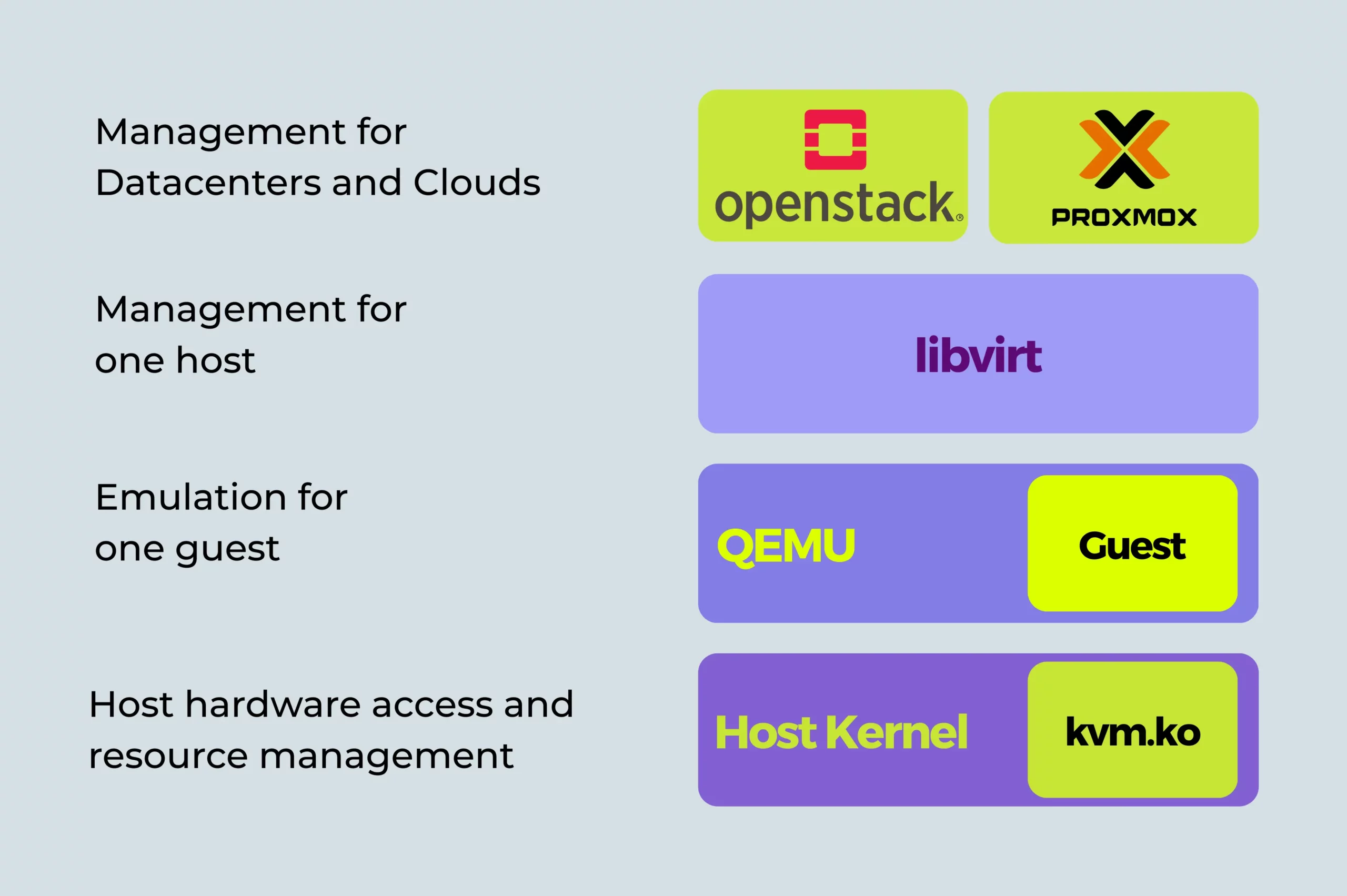
The Role of QEMU and Libvirt in KVM Virtualization
While KVM provides the core virtualization capabilities, QEMU and libvirt play essential roles in making KVM a fully functional virtualization stack.
QEMU
QEMU is a generic, open-source machine emulator and virtualizer. As a user-space emulator, it enables essential device emulation, allowing virtual machines to interact with virtualized hardware components.
It enhances KVM by enabling features such as VM snapshots, live migration, and advanced networking options. QEMU uses hypervisors like XEN or KVM to use CPU extensions (HVM) for virtualization.
When used as a virtualizer, QEMU can achieve near native performance by executing the guest code directly on the host CPU.
Libvirt
Libvirt is another piece of software designed to simplify the management of virtual machines and related virtualization tasks, including storage and network interface management.
Libvirt is a widely used virtualization management framework that abstracts the complexity of KVM and QEMU. It provides a unified API and a set of command-line tools (such as virsh) to manage VMs, networks, and storage, making KVM-based virtualization easier to deploy and maintain. Besides KVM, it also supports XEN hypervisor and LXC containers.
KVM Management – libvirt
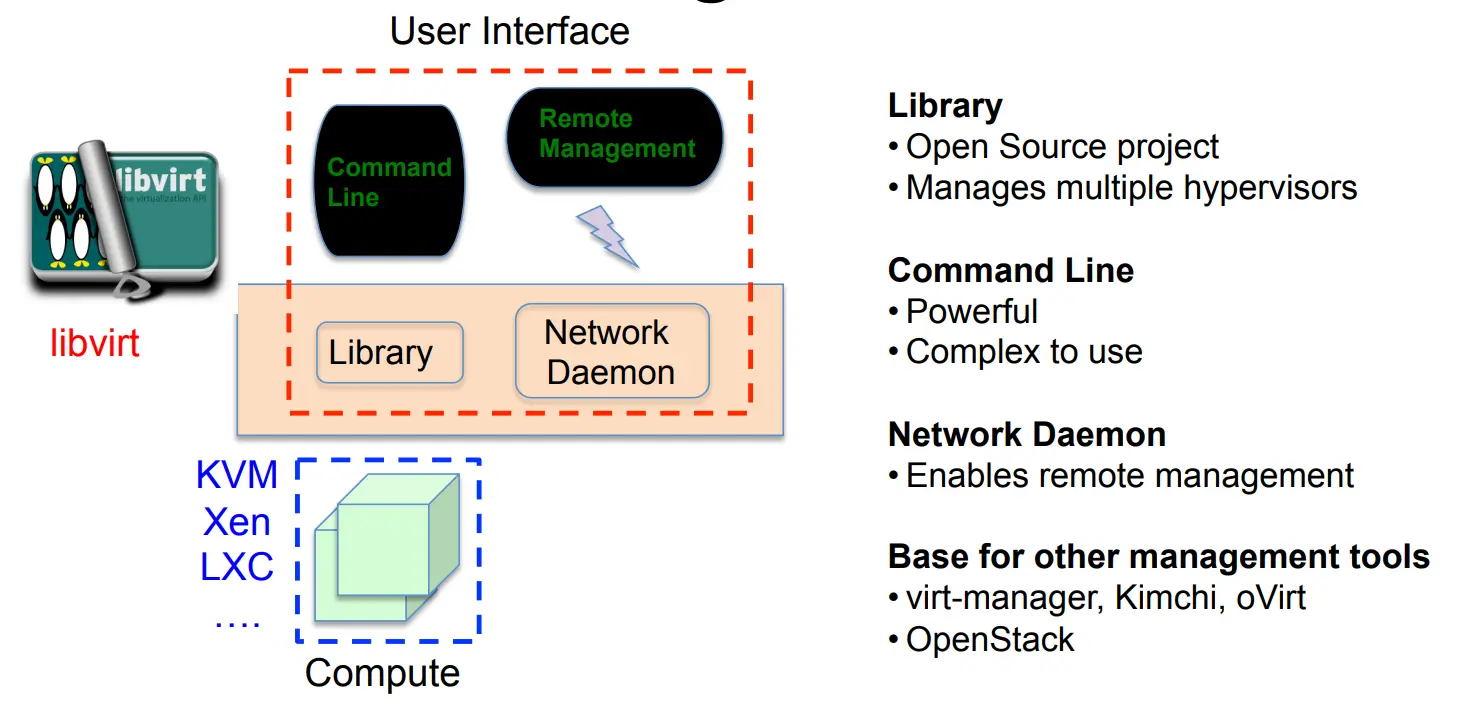
KVM meets OpenStack
OpenStack is a widely adopted open-source cloud computing platform designed to manage distributed compute, network, and storage resources within data centers. It acts as an orchestration layer that aggregates physical infrastructure into a unified pool and enables users to provision virtual resources (VMs, storage, networks, routers) on demand through a self-service portal or APIs. You can learn more about OpenStack in our previous post here.
While OpenStack itself does not do virtualization, it integrates seamlessly with KVM to provide virtualization capabilities. By leveraging KVM as a default hypervisor with libvirt, OpenStack allows organizations to build cost-effective, scalable, and vendor-independent cloud environments without any license costs.
In recent years OpenStack has emerged as a great alternative to proprietary cloud and virtualization solutions from VMware and Microsoft and today it helps businesses all over the world to optimize costs and compete with hyperscale cloud providers.
Why Choose KVM?
In almost 20 years of its existence, KVM has become the virtualization standard for public cloud providers due to its performance, scalability, and open-source nature. Cloud giants such as AWS, Google and Oracle have adopted KVM because it:
- Delivers near-native performance through hardware-assisted virtualization.
- Supports live migration, enabling seamless VM movement across physical hosts without interruption.
- Provides strong security features, including sVirt (SELinux integration) and Seccomp.
- Avoids vendor lock-in, giving organizations full control over their infrastructure and costs.
- Scales efficiently, handling everything from few VM deployments to hyperscale cloud environments with hundreds of thousands of VMs.
- Has broad industry adoption, with an active open-source community and enterprise-grade solutions from multiple vendors including Red Hat and Canonical.
Closing Thoughts
KVM has solidified its position as a leading open-source hypervisor, enabling cloud providers and enterprises to build scalable, efficient, and secure virtualization environments. As the default hypervisor for OpenStack and Cloudification’s c12n, KVM continues to be the backbone of modern cloud infrastructure, providing an open, flexible alternative to proprietary solutions like VMware ESXi and Microsoft Hyper-V. Its widespread adoption by major cloud providers demonstrates KVM’s reliability and performance, making it the go-to choice for virtualization in the cloud era.
Are you considering integrating KVM into your cloud infrastructure or optimizing your OpenStack environment? We offer dedicated cloud consulting services and already have a ready-to-implement solution tailored to your needs. Contact us today and let our experts help you build a scalable, cost-effective, and high-performance cloud infrastructure.

